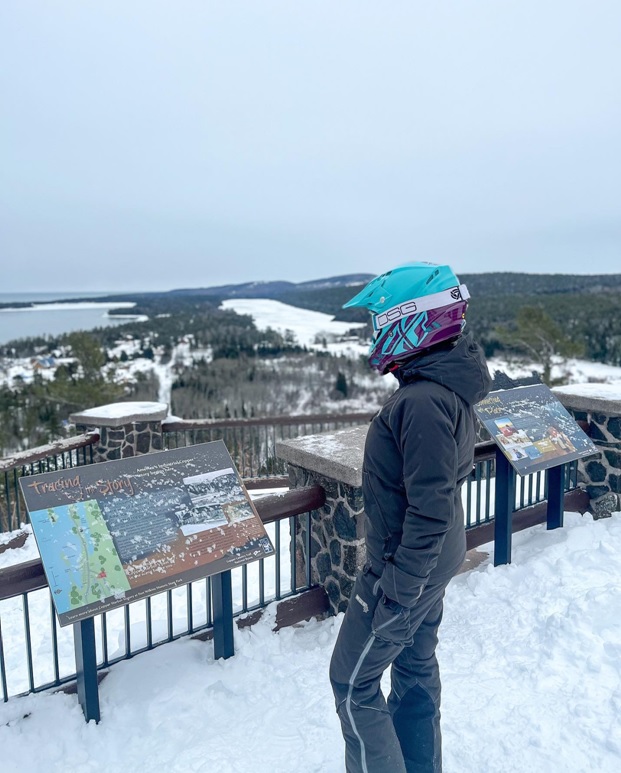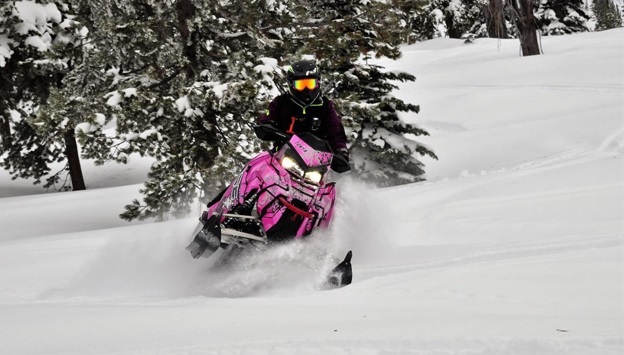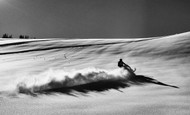Advice for First-Time and Beginner Snowmobilers
Feb 1st 2023
Snowmobiling can be a fun, rewarding way to get outside and be in the elements when everyone else is snuggled up inside. Moreover, it can be a great way to travel overland and access remote areas in the winter that can only be accessed (otherwise) on foot. Only, on a snowmobile, you can cover more ground, so much faster.
Don’t let lack of familiarity keep you off the powder and out of the backcountry. Even if you’ve never gone out before, there is a world of opportunity waiting.
Besides, you can learn from our experience. Here are some top tips for beginners and first-timers.
Staying Warm (and Dry)
Thermoregulation is of the utmost importance when you’re out in the winter, and we say thermoregulation because it’s just as important that you don’t overheat as it is that you stay warm.
That’s why our women’s snowmobile gear, such as our women’s snowmobile jackets, are made with underarm vents, DWR (durable, water-repellent) finishes, and 100% seal-taped seams. They are not only designed to keep you dry but to keep you cool, so you don’t overheat and sweat, which can be deadly in the extreme cold.
Layering is also essential. You’ll need a base layer to keep you cool and dry, a warm mid-layer to trap heat, and a quality outer shell like one of our women’s snowmobiling jackets that will keep you dry and, if you exert yourself, cool as well.
Always Wear a Helmet (No Matter What)
Never, never ride without a helmet. People are seriously injured (and killed) every year when out riding snowmobiles. Do not become one of these statistics; always observe proper safety precautions, and safety rule number one is always to wear a helmet when riding.
There’s another reason; your helmet probably has a visor built in that will not only keep the snow and wind out of your face, but will cut the glare - and believe us, even in low-light conditions, the reflectivity of snow can blind you in a matter of minutes. Snowblindness is a quick way to ruin any backcountry trip.
Keep Your Carbs Clean
In some ways, your snowmobile’s carburetors, or carbs, are like the heart of the engine. They mix fuel and air in the proper proportions, ensuring optimal combustion.
However, over time, carbs get gummed up with residue that can adversely impact the performance of your engine. Your snowmobile’s carbs can actually get so dirty that the engine won’t run!
The best solution to this issue is to prevent it before it happens. Unless you’re riding out on a brand new or recently serviced machine, partner up with a friend who has some experience with this sort of thing and clean your carbs before you head out.
You’ll need pliers, a screwdriver, and a wrench and sockets, as well as carb cleaner, rags, and brushes. Before cleaning, turn off the fuel valve to prevent gas spills, then remove the carb and clean.
This is where it gets tricky, as you’ll want to know what you’re doing before proceeding. This is a pretty good tutorial on snowmobile carb cleaning, but if you aren’t comfortable doing so yourself and don’t have a friend that knows how to do it, turn to a mechanic for professional service.
Just make sure you have your carbs cleaned and your snowmobile serviced according to manufacturer specifications.
Learn to Use Hand Signals
While you’re snowmobiling, you can’t use your voice to communicate over the sound of the engine. Hand signals work best.
The left arm is used for signaling. The 4 most important hand signals you’ll want to learn to use are:
- Left turn: Extend your left arm out perpendicular to your body, parallel with the ground.
- Right turn: Extend your left arm, with the upper arm parallel to the ground; elbow bent 90° with the left hand pointing towards the sky.
- Stop: Extend left arm straight up towards the sky.
- Slowing down: Extend your left arm away from your body, parallel to the ground, sweep downwards towards your body.
However, there are 7 essential signals in total. You can see a helpful visual for snowmobile hand signs at the following link.
Learn to Read Trail Signs
Just like the use of hand signals, learning to read trail signs is also essential to snowmobile riding.
Where snowmobiling is common, there are three main signs you’ll need to recognize. One is the sign for “No Snowmobiles,’ which indicates snowmobiles are not allowed.
The other two are for designated trails which are blazed orange, and for trails on which cross-country skiing is permitted, which are blazed blue.You’ll need to know which is which!

Be on the Lookout for Other Riders
Just as you would be in a car, you should always have your antenna up and wits about you when snowmobiling. Always be on the lookout for other riders, as this can help prevent accidents. Don’t assume that just because you are conscientious, other riders are, too.
Also, keep your eyes open for obstacles in the snow, as heavy snowfall can obscure logs and rocks which can be very dangerous. There could also be hikers and skiers out, too; be on the lookout for these as well and always be ready to react.
Know the Law
It might sound obvious, but always be aware of the law where you are riding. Though it may not apply to riders on private land, if you are on public land, be aware of the locations where you can and cannot ride. This can help you avoid citations and fines.
Also make sure you are up to date with any licenses, insurance, and regulation necessary to keep you compliant with the law.
Stay Hydrated
As we covered previously in our “Beginner Snowmobiling: 10 Things I Wish I Knew,” keeping hydrated is imperative. You can easily get dehydrated on the trail.
Also, bring an all-metal water bottle. They’re much more durable and reliable than plastic, and if you run out of water, you can melt snow in the metal bottle by heating it - but don’t use body heat, as that will cost you precious calories.

Always Be Prepared
Finally, make sure you always carry along the essentials. We’ve already posted on this in the past, so for details, consult our previous blog, “Packing for a Successful Snowmobile Outing,” for more information.
Gear Up: Women’s Snowmobile Jackets, Monosuits, Bibs, and More
Here at DSG Outerwear, we’re doing something good. We’ve designed outerwear, by women, and for women, that will keep you warm, dry, and comfortable on the trail. Check out our collections and if you have any questions or concerns, get in touch with us at Sales@DSGOuterwear.com.
Be prepared and stay safe out there on the trail this winter!

